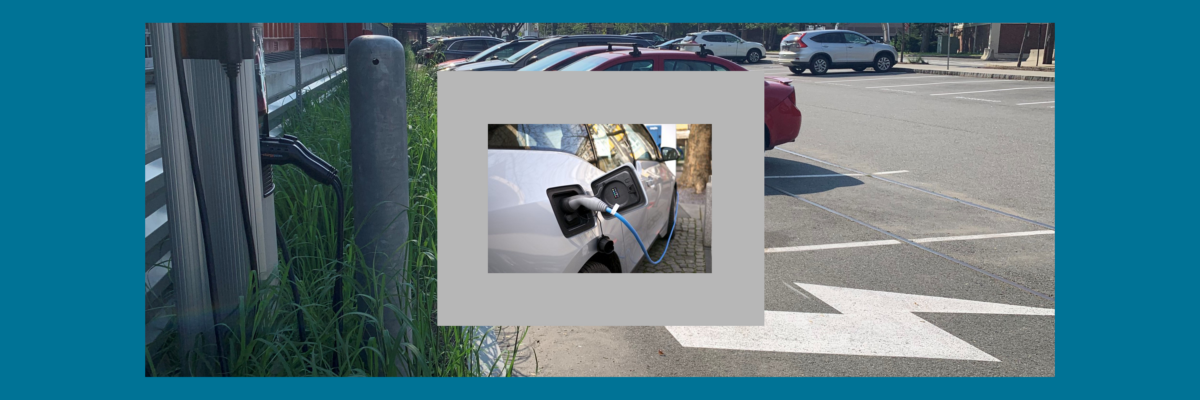by Rachel Fishman
The age of the electric vehicles has arrived and it’s here to stay. In a recent poll, 56% of Massachusetts respondents say they are likely to purchase an EV in the next five years. The Infrastructure Investment and Jobs Act will supply $7.5 billion to build a nationwide network of charging stations.
The transition is happening, but drivers vary by demographic: Data show that typical EV owners continue to be middle aged, wealthy men. Large segments of the population aren’t yet on board in a meaningful way.
EV carsharing is an important way to increase access to EVs. I am helping to coordinate and lead one example currently offered by the City of Boston and its partners. The Good2Go income-tiered pilot program began in 2021. We are off to a good start but need more charging infrastructure.
Where are Drivers Charging Up?
Another essential way we can make EVs more accessible to drivers – (and to EV carsharing programs!) – is to provide charging stations in settings where EV owners need, and want, to charge their vehicles.
Almost three-quarters of today’s EV owners are also homeowners. Right now, more than 80% of charging happens at home. Massachusetts utilities like Eversource and National Grid will even pay for some at-home charging station installation costs through their “Make Ready” programs. In other words, if you own your own home and have a garage, it’s pretty easy to charge an EV.
For people who don’t own a home or don’t have a garage, things get a little more challenging. While funding from the Infrastructure and Jobs Act will increase the number of public charging stations across the country, we need a targeted approach to make EVs a better choice for renters and apartment dwellers. In addition to growing the number of charging stations in public parking lots, along highways, and at retail/dining establishments, this also involves ramping up multifamily, renter and on-street charging.
Curbside EV Charging
You’ve probably seen charging stations in parking lots. Installing charging stations along streets is also becoming increasingly popular. It’s a great way for people to charge while out and about, and importantly, it’s a way for those without a charging station at home to access one.
Some towns and utilities are opting for pole-mounted charging stations. An example of a city with a successful pole-mounted charging station program is Melrose, MA. The Melrose program launched in April 2021 in partnership with National Grid. The pilot’s success was a reason National Grid is proposing to expand such a program in its latest MA DPU filing.
In some areas (e.g., Boston) pole-mounted charging stations aren’t feasible. In Boston, this is due to underground utility wires throughout most of the city that run to poles used exclusively to power streetlights. Since streetlights are only turned on at night, the poles aren’t powered in daytime.
Another way to access curbside charging is by installing free-standing charging stations. In New York City, 34 curbside charging stations are being installed to facilitate more EV adoption. Boston is following suit with its first curbside installation in Roxbury. This charging station will be used by Good2Go, enabling people who need a car for short trips to access an EV.
EV Charging at Apartments and Condos
In Massachusetts, 42.7% of all residents live in a multifamily home. This can present a challenge bringing in charging stations, since often condominium boards, fellow condo owners or building owners need to approve installations. Typically, installing a charging station on private property only requires an electrical permit, but information about the steps to install charging stations can sometimes be difficult to find.
To help obtain condo board or building owner approval, Somerville, MA created a letter template. In New York, legislation passed in 2019 restricts condo boards from prohibiting or unreasonably restricting unit owners’ installation or use of charging stations within the community. This law can serve as a model for other states.
EV Charging for Renters
In addition to the same challenges faced by apartment dwellers and condo owners, charging is often particularly challenging for renters. Massachusetts has the eighth-lowest homeownership rate among states: 37.8% of Massachusetts residents rent their living space.
Renters need landlord approval to install a Level 2 charging station and can cause challenges in obtaining at-home charging. Because 30% of renter households in Massachusetts are low-income, this is an equity issue.
In Conclusion
Charging access must be more equitable if EVs are going to become the most common cars on the road. We know that at-home, garage-based charging is not accessible for everyone. We know there are often barriers to renters, condo owners and apartment dwellers seeking convenient charging. Let’s make it easier for renters, condo owners, apartment dwellers and EV carsharing members to access charging at home or on the street. When this is broadly in place, there will be one more good reason for people to choose an EV.
–Rachel Fishman is a Project Manager at E4TheFuture
